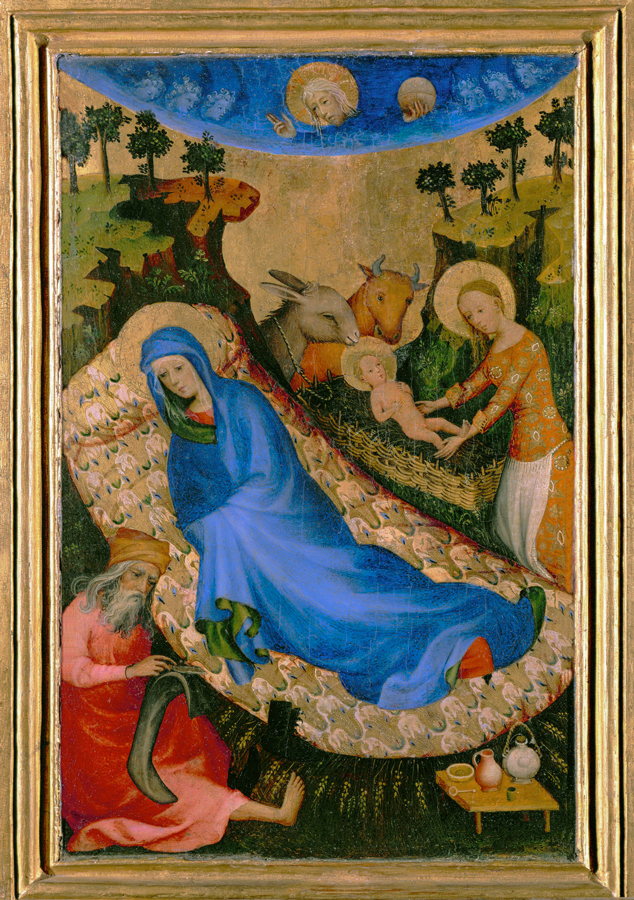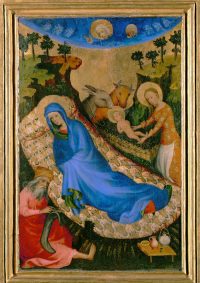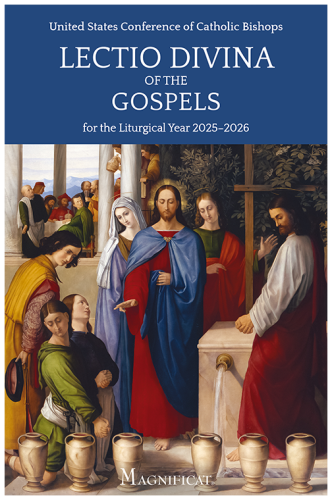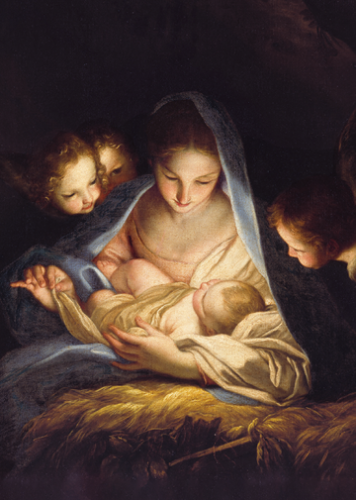Nativity (c. 1400), Anonymous,
Museum Meyer van den Bergh
In 1400, the Duchy of Burgundy was at its zenith, stretching from the Saône River to the North Sea, with fertile lands and lively mercantile trade. The Burgundian dukes vied with the king of France for power and prestige, and their glittering courts served the finest foods while flaunting the most glamorous fashions. Yet this little panel, one of four pieces produced for the private devotions of Duke Philip the Bold, seems to mock the magnificent repasts and the splendid regalia of the Burgundian court.
The anonymous painter captured a cultural crossroads in this little gem. The gold background and the amorphous gilt mattress of the Virgin reveal a Byzantine influence, yet the craggy rocks and the woven bassinet indicate awareness of the artistic innovations of the Italian proto-Renaissance. The swathe of lapis blue in the upper portion where God the Father looks down on the scene, flanked by faintly traced angel faces framed by curls, nods to the illuminated manuscripts, the preferred form of private prayer in this era. Indeed, Philip the Bold’s Book of Hours, now in the Fitzwilliam Museum (Cambridge, England), contains over two hundred images and anticipated the celebrated Très Riches Heures du Duc de Berry by almost fifty years.
Humility amid splendor
The foreground evokes a different, far humbler world. Saint Joseph sits awkwardly in the lower left-hand corner, his bare foot extended along the lower edge of the panel. Across from his splayed toes stands a simple wooden table, probably the carpenter’s handiwork, laid with some rustic crockery. Joseph has cast off his boots and is intent on tearing his long stockings, a seemingly odd activity to be absorbed in during the Nativity.
Saint Joseph, however, is subtly yet surely the hero of the piece. The 13th century had seen the arrival of the first Josephine relic, his hosen or socks, given by the saint at Christ’s birth to be used as swaddling clothes. Laid in a trough, swathed in rags, Jesus entered the world in the least exalted of circumstances. The relic of the hosen was kept in Aachen, right on the Burgundy border, and helped to popularize the devotion to Saint Joseph as humble provider for the needs of the Savior. The panel shows Joseph stripping his poor garb from his body to give to the naked child, and indeed Christ’s raised foot mirrors Joseph’s below.
In contrast to the golden mattress flecked with floral embroidery of the Virgin, or the flame-colored brocade of the midwife’s dress, Joseph’s rose robe stands out for its simplicity. He is most like the Christ Child, nude on the ground above. Both God the Father and the Blessed Virgin turn towards Joseph, drawing the eye of the viewer to his seemingly incongruous actions.
The example of Saint Joseph
Devotion to Saint Joseph took an interesting turn in the 15th century. From the isolated and elderly man of earlier art, fashioned to safeguard the teaching of Mary’s virginity, Joseph developed new guises. Several areas in Northern Europe depicted him as an almost comical figure, involved in some mundane task as the earth-shattering events took place nearby. This panel belongs to that trend, deriving much of its imagery from apocryphal texts.
Apocrypha, stories not included in the Biblical canon, became increasingly popular in the early Renaissance. Accounts like The Infancy Gospel of Thomas or Pseudo-Matthew satisfied a popular hunger to know more about the lives of history’s most important people: Jesus, Mary, and Joseph, the latter a subject of exponentially increasing interest.
The Protoevangelium of James, probably written in the 2nd century, partially inspired this panel. Saint Joseph, having settled Mary in the cave in Bethlehem but not knowing what to do, went in search of a midwife. He found Salome, but when they arrived Jesus was already born. Salome refused to believe in Mary’s virginity, and her lack of faith caused her hand to wither, but when she picked up the Christ Child she was miraculously cured.
The sacred figures at the center of the panel are framed by ordinary mortals who doubt or fuss, yet the point of the work is not to deride Joseph, but to help the beholder feel closer to the story. The new focus on Joseph’s seemingly trivial activities served as a gentle reminder that most of us are ineffectual bystanders in the great event of salvation. We certainly aren’t the Savior or his bearer, nor do we have any special skills to assist in the event. Yet we aren’t mute animals content to gaze idly by.
As Joseph gave what he could to participate in the history of salvation, sacrificing warmth and comfort in his humble way, we can follow his example by stripping off our pride and attachments to serve the Lord. It is edifying to think that Duke Phillip, who in 1400 was one of the most powerful men in Europe, chose to focus on the humble custodian of the Christ Child in his personal devotions and bring this image with him as he traveled through his vast domains. In this unique work, Saint Joseph illustrates the most important quality of a leader, the willingness to sacrifice personal comforts for the care of his people—truly a precursor of Christ.
Elizabeth Lev
Writer and professor of art history in Rome.
Nativity (c. 1400), Anonymous, Museum Meyer van den Bergh, Antwerp, Belgium. © akg-images / Erich Lessing.













Additional art commentaries